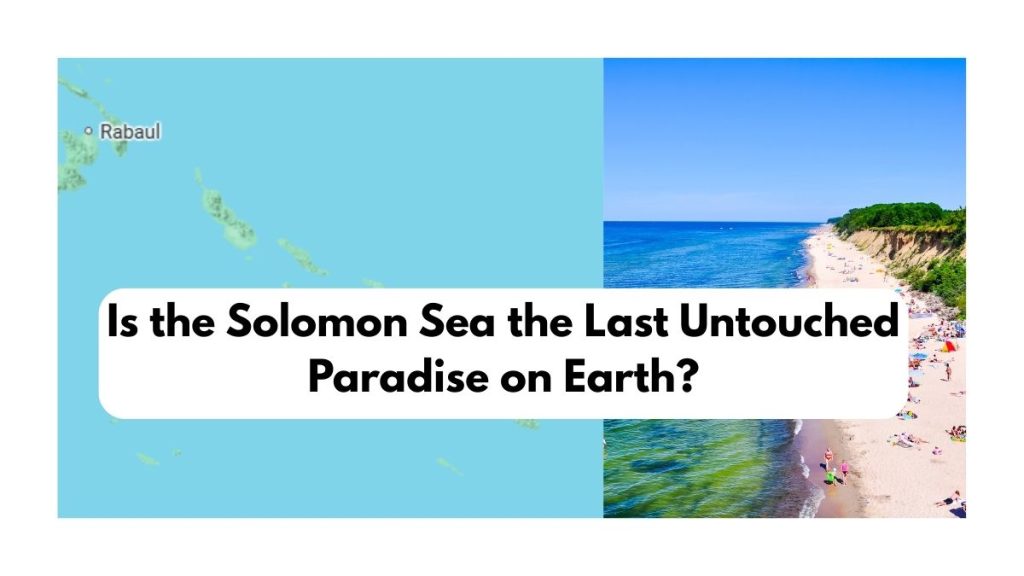The Solomon Sea (click here to see map), nestled between Papua New Guinea and the Solomon Islands, is one of the most biodiverse and fascinating marine regions on Earth. Known for its vibrant coral reefs, WWII shipwrecks, and unique marine species, this sea is a paradise for divers, scientists, and adventure seekers.
But what makes the Solomon Sea so special? Why is it crucial for marine biodiversity? And how is climate change affecting it? Let know answer of these questions.

Where is the Solomon Sea Located?
The Solomon Sea is a marginal sea in the South Pacific Ocean, bordered by:
- Papua New Guinea (North & West)
- Solomon Islands (South & East)
- New Britain & Bougainville Island (Northeast)
Key Coordinates:
- Latitude: 5°S to 11°S
- Longitude: 150°E to 160°E
Connected to:
- Coral Sea (via the Solomon Strait)
- Pacific Ocean
Solomon Sea vs. Coral Sea: Quick Comparison
| Feature | Solomon Sea | Coral Sea |
| Depth (Max) | ~9,140m (New Britain Trench) | ~9,140m (Queensland Trench) |
| Coral Reefs | Rich but less explored | Great Barrier Reef (largest) |
| Marine Life | High biodiversity, WWII wrecks | More touristy, famous reefs |
| Tourism | Emerging diving spots | Well-established |
How Deep is the Solomon Sea?
The Solomon Sea is one of the deepest seas in the world, with:
- Average depth: ~4,000 meters
- Deepest point: New Britain Trench (~9,140 meters)
Fun Fact: The pressure at the bottom of the New Britain Trench is 1,000 times greater than at sea level!
Marine Life: A Biodiversity Hotspot
The Sea is home to some of the most diverse marine ecosystems, including:
Unique Marine Species
- Reef sharks (Blacktip, Whitetip)
- Manta rays (Giant oceanic species)
- Dugongs (Sea cows, endangered)
- Humphead wrasse (Rare, colorful fish)
Coral Reefs & Ecosystems
- Marovo Lagoon (Potential UNESCO site)
- Kimbe Bay (Over 860 fish species)
- Lesser-known reefs (Underexplored, pristine)
.
Best Diving & Snorkeling Spots
If you love underwater adventures, these are the must-visit spots:
| Location | Highlights | Best Time to Visit |
| Marovo Lagoon | World’s largest double barrier reef | April – October |
| Bonegi I & II (Solomon Islands) | WWII shipwrecks (Japanese transports) | Year-round |
| Kimbe Bay (PNG) | Coral gardens, hammerhead sharks | May – November |
| Russell Islands | Manta ray cleaning stations | June – September |
Why is the Solomon Sea Important?
Ecological Significance
- Acts as a breeding ground for tuna and other fish.
- Influences Pacific Ocean currents.
- Home to endemic species found nowhere else.
Economic Value
- Fishing industry (Tuna exports).
- Eco-tourism (Diving, snorkeling).
Major Threats
- Climate change (rising sea temps → coral bleaching).
- Illegal fishing (depleting fish stocks).
- Plastic pollution (microplastics harming marine life).
5 Facts About the Solomon Sea
WWII History – Over 100 shipwrecks from WWII battles lie on its floor.
Volcanic Activity – Part of the Pacific Ring of Fire (undersea volcanoes).
Deepest Trench – The New Britain Trench is deeper than Mount Everest is tall!
Indigenous People – Coastal communities rely on the sea for survival.
El Niño Impact – The sea’s temperature affects global weather patterns





























